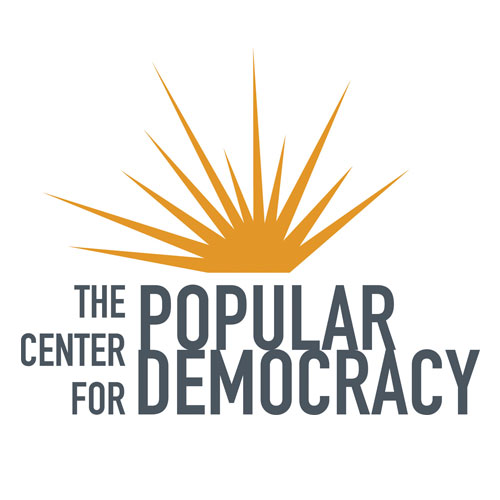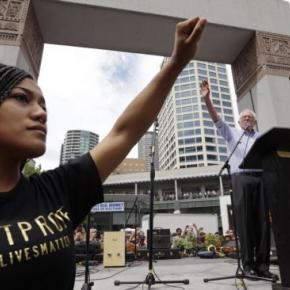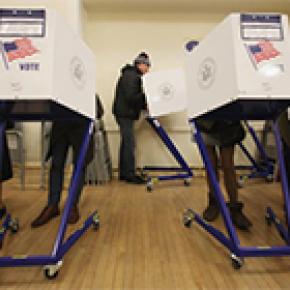Black Community Seeks the Power of the Ballot
Source: Vox...
Source: Vox
For black communities in the United States, presidential election participation rates are strong and momentum is building.
In 2012, black voters showed up at the polls in the largest numbers (66.2 percent) and voted at a higher rate than non-Hispanic whites (64.1 percent) for the first time since rates were published by the U.S. Census Bureau in 1996.
Black Americans tend to vote Democratic in presidential elections. This was true by historic margins in President Barack Obama's 2008 and 2012 victories— 95 and 93 percent, respectively. And their turnout rate in 2016 could be an important factor in deciding the next president of the United States, especially in a tight race.
That's good news for black community leaders who want to ensure their voices are heard and hold future leaders accountable.
Civil rights leadership
The 2014 and 2015 cases of deadly police force against unarmed African-Americans have galvanized a tech-savvy generation of activists to inject new life in an age-old push for racial, economic and social equality.
More and more, movements such as Black Lives Matter are becoming international household names and are holding candidates accountable to specifically address and push for legislation on these issues.
One such organization, Black Alliance for Just Immigration (BAJI), engages and advocates on behalf of African-American and black immigrant communities on issues of racial justice and immigrant rights.
BAJI's policy and legal manager, Carl Lipscombe, says part of the greater push nationwide to organize and bring to light instances of police brutality results from what he describes as a community-wide fear of "being killed when walking to the corner." He says these police cases are enhanced by the advent of social media and by the ability to capture events on camera that wasn't possible in the 1980s.
Lipscombe says candidates must do more than "throw a bone" if they expect communities of color to go to the polls in droves.
"It's not enough to just say we want free education for everyone," Lipscombe said. "We want to know how this is going to impact black people."
According to the U.S. Bureau of Labor Statistics, the unemployment rate among blacks in the United States, at 9.4 percent, remains significantly higher — nearly double — than the overall rate of 5 percent nationwide.
Black wealth also has declined. The non-partisan Economic Policy Institute, in coordination with the liberal research institution Center for Popular Democracy, reports that black workers' wages have fallen by 44 cents on the hour in the past 15 years, while wages of both Hispanic and white workers have increased by approximately the same amount.
African immigrant concerns
The Migration Policy Institute reports that black immigrants from Africa are better educated than the overall U.S. population, age 25 and older.
In 2007, 38 percent held a four-year degree or more, compared to 27 percent of the U.S. population. Yet, black immigrants earn lower wages and hold the highest unemployment rate in comparison to other immigrant groups, according to the Center for American Progress.
Bakary Tandia, case manager and policy advocate at African Services Committee, a Harlem-based agency dedicated to assisting African immigrants, refugees and asylees, says progress is necessary across all levels of government.
"Even if you take the case of [New York City Mayor Bill] de Blasio,” Tandia said, “he is a progressive mayor, but in his administration, I have not seen any African immigrant appointed or in a meaningful position, and the same thing goes at the state level, at the federal level."
New leadership
Grass-roots coordinators say anti-immigration rhetoric among some presidential candidates has fueled electoral participation, as well as greater community leadership.
Steve McFarland, whose organizing efforts include get-out-the-vote campaigns among disenfranchised communities in New York, says the immigration reform movement, combined with the work of Black Lives Matter, has produced a new generation of civil rights leaders.
"It doesn't look the way that it used to look," McFarland said. "It's not big organizations, but they can mobilize people, they have a clear voice, and they are winning changes across the country."
Ahead of the 2016 presidential primaries, there is good news for Democratic frontrunner and former secretary of state Hillary Clinton. She currently enjoys an 80 percent favorability rating among adult blacks, the highest positive net rating of all candidates, according to a recent Gallup poll.
Clinton, who has met privately with Black Lives Matters activists, specifically addressed racial profiling in an October speech at Clark Atlanta University.
"Race still plays a significant role in determining who gets ahead in America and who gets left behind," Clinton said. "Racial profiling is wrong, demanding, doesn't keep us safe or help solve crimes. It's time to put that practice behind us."
NYTimes Letter to the Editor: Deportations for Minor Offenses
New York Times - April 13, 2014 To the Editor: Re “...
New York Times - April 13, 2014
To the Editor:
Re “More Deportations Follow Minor Crimes, Data Shows” (front page, April 7):
It’s a mistake to focus the debate about immigration enforcement on the question of which immigrants are sufficiently “criminal” to deserve deportation. When the Obama administration talks about deporting people with convictions, they are talking about people who have already served their sentences for those convictions.
If you are a citizen who commits an offense, you pay the penalty issued by the criminal legal system, and then you are free to try to rebuild your life. If you are a noncitizen who commits that same offense and pays that same penalty, you can be subjected to the double punishment of permanent exile from your home and family.
This two-tiered system of justice is morally abhorrent regardless of how serious the underlying offense may have been. It’s an unfairness compounded by the well-documented unfairness of the criminal legal system itself, which disproportionately targets poor people and minorities.
Let’s not rely on our corrupt criminal justice system to justify the operations of our corrupt immigration system.
EMILY TUCKER Brooklyn, April 7, 2014
The writer is staff attorney for immigrant rights and racial justice at the Center for Popular Democracy.
Source
Minimum wage going up
Voters have decided it’s time to give Colorado’s minimum-wage workers a long-overdue raise. Amendment 70, a measure...
Voters have decided it’s time to give Colorado’s minimum-wage workers a long-overdue raise.
Amendment 70, a measure that would increase Colorado’s minimum wage to $12 an hour by 2020, was passing by a 10-percent margin. Minimum wage in the state is now $8.31 an hour.
With 25 of 64 counties reporting, the vote-count as of this posting was 55 percent yes to 45 percent no.
In a crowded, jubilant second-floor conference room at the Westin Downtown, a group of minimum wage earners, business owners and advocates celebrated.
“Amendment is going to help our local economy,” said Edwin Zoe, proprietor of restaurant Zoe Ma Ma. “When low income workers do well, we all do well.”
The amendment alters the state constitution to increase the minimum wage by yearly 90-cent increments until it reaches $12 in 2020. In 2020, it will be fixed at $12, except for yearly adjustments to account for inflation.
Who pushed it over the finish line?
Supporters of the increase coalesced in mid-2016 into a group called Colorado Families for a Fair Wage, a coalition of unions, economic justice advocates and progressive policy analysts. Many of them had been part of an informal consortium of anti-poverty groups called The Everyone Economy that came together to strategize about raising the minimum wage back in February 2014. Partnering with Democratic legislators, they advocated for a pair of bills in the 2015 legislative session to help low-wage workers. One would have allowed municipalities to set their own minimums, and the other would have created a ballot measure to reach a $12.50 per hour minimum by 2020. Republicans killed both bills in the Senate.
Democrats floated another bill in 2016 to allow cities to set their own minimum wages, which met the same fate as its predecessors. After that, Everyone Economy members decided they had no recourse but to pursue a ballot measure themselves and formed Colorado Families for a Fair Wage.
What does it mean that it passed?
The work is just beginning for Colorado labor unions and low-wage worker advocates. Most CFFW members acknowledge that $12 per hour is not in fact a living wage for workers with families in some parts of Colorado. Most estimates put a living wage for a single parent of two children in Denver at around $30 per hour. But advocates also believe that the current $8.31 per hour is inexcusable, and any more than $12 was not politically viable this time around.
But for some, the increase means a change in their lives. April Medina currently makes $11 per hour in assisted living. She works 60-70 hours per week, leaving very little time to spend with her four children. She brought her 9-year-old daughter, Jasmine, to the Westin Downtown to celebrate Amendment 70’s passage.
Medina said she was thrilled by the news.
“I’m excited to go to some basketball games,” Medina said.
How much firepower was against it?
Keep Colorado Working had a slower start raising funds, but raised $1.7 million in the last reporting period. It has spent just under $1.4 million as of the most recent campaign finance filings, primarily on television advertising and consultants. About half of its funds ($650,000) come from the Alexandria, Virginia-based Workforce Fairness Institute. It has also gotten $525,000 from Colorado Citizens Protecting Our Constitution, a committee that has donated hefty sums to pro-fracking campaigns and to a 2013 effort to recall legislators who had passed gun-control legislation.
CCFW outraised its rivals almost 3 to 1, raising about $5.3 million in donations, much of it from out-of-state groups like its largest donor, the Center for Popular Democracy, which has kicked in over $1 million. Its second-largest donor is the Palo Alto-based Fairness Project, which has contributed over $960,000 to CFFW and is also supporting minimum wage ballot measures in Maine, Arizona and Washington, D.C.
Keep Colorado Working wants to make sure you know that some of CFFW’s donors are not from Colorado. Virtually all of its communications use the terms “wealthy out of state special interests” liberally.
According to the most recent campaign finance filings, CFFW has spent $4.6 million on television and digital advertising, outreach efforts like canvassing and hosting events, mailers, polling and research.
By Eliza Carter
Source
EXCLUSIVE: City Offices Fail to Meet Law Requiring Them to Help New Yorkers Register to Vote
New York Daily News - October 21, 2014, by Erin Durkin - City agencies are failing to do their part to make voter...
New York Daily News - October 21, 2014, by Erin Durkin - City agencies are failing to do their part to make voter registration easier — even though they’re required to by law.
Legislation passed in 2000 mandates that 18 agencies give voter registration forms to visitors. But the Center for Popular Democracy found that 84% of those visitors were never offered a chance to register, according to a report to be released Tuesday.
In fact, 60% of the agencies didn’t even have forms in the office. And 95% of the clients were never asked if they wanted to register to vote.
“This is an urgent problem which is leading to the disenfranchisement of many thousands of low-income New Yorkers,” said Andrew Friedman, the group’s co-executive director.
The group found that 30% of people who visited the city offices weren’t registered to vote, higher than the national average.
Mayor de Blasio’s spokesman Phil Walzak said Hizzoner has ordered agencies to step up their compliance with the law.
Advocates say having city agencies help out with voter registration is especially important because most people nationwide sign up to vote at motor vehicle departments, but many city residents don’t drive.
Source
Bankers and Economists Fear a Spate of Threats to Global Growth

Bankers and Economists Fear a Spate of Threats to Global Growth
GRAND TETON NATIONAL PARK, Wyo. — In the decade since the financial crisis, economic policy makers, professors and...
GRAND TETON NATIONAL PARK, Wyo. — In the decade since the financial crisis, economic policy makers, professors and protesters have gathered here every August to argue about the best ways to return to faster economic growth.
This year, they gave up.
Read the full article here.
Report Shows Illinois Has One of the Nation’s Highest Black Unemployment Rates Despite an Improving Economy
Report Shows Illinois Has One of the Nation’s Highest Black Unemployment Rates Despite an Improving Economy
Across the country, the economy is supposed to be slowly picking up, but the unemployment rate for Blacks is still...
Across the country, the economy is supposed to be slowly picking up, but the unemployment rate for Blacks is still about twice the rate of whites. A report by Progress Illinois said the state’s Black unemployment rate is one of the worst in the nation.
According to analysis by the Economic Policy Institute (EPI,) only two other states, New Jersey and South Carolina have higher Black unemployment rates than Illinois. D.C. had the highest Black unemployment rate at 14.2 percent, while Tennessee had the lowest at 6.9 percent. Illinois’ Black unemployment rate declined to 11.5 percent in the second quarter of 2015, according to Progress Illinois.
The nationwide unemployment rate has fallen to about 9 percent. However, the Black jobless rate is twice the white unemployment rate of 4 percent, according to the Bureau of Labor Statistics.
“African Americans are still unemployed at a higher rate than their white counterparts in almost every state,” said EPI economist Valerie Wilson, who conducted the unemployment analysis. “We need policies that look beyond simply reducing unemployment to pre-recession levels as an end goal.”
In a press release, Connie Razza, director of strategic research for the Center for Popular Democracy (CPD), said, contrary to the improving economy, “Black America is still in the middle of a Great Recession.”
According to Progress Illinois, EPI and the Center for Popular Democracy both called on the Federal Reserve to support policies that would help Black America.
“When [Fed] Chair [Janet] Yellen and other Fed officials talk about raising interest rates in 2015, they are talking about intentionally slowing down the economy and job growth, which would make it harder for most Americans, and particularly Black workers, to find good-paying jobs,” Razza said. “The direct consequences of the Fed’s projected interest rate hikes would harm millions of workers.”
A tight labor market, which we have now, benefits employers since there are more people looking for fewer jobs. This allows employers to keep labor costs low and easily fire workers, because there are hundreds of people lined up to replace them. Razza said the Fed needs to support policies that would move towards a full employment economy.
“A full-employment economy, as we saw in the late 1990s, shrinks racial inequity and will bring particular benefits to Black workers, who are disproportionately unemployed, underemployed, underpaid, and endure more difficult scheduling circumstances in the workplace,” Razza said.
Black unemployment has been a long-standing problem. The Labor Department began tracking employment figures by race in 1972 and since then the Black jobless rate has stubbornly remained at twice the white rate. Employment experts say its not just a matter of training and education. Studies have shown Black men with college educations have higher unemployment rates than white men with just a high school education.
However, economists say the improving economy is making it easier for all Americans, including Black people, to find work.
“Now, you’re starting to see a broad recovery which is reaching groups with high unemployment rates like African-Americans and teens,” said Michael Madowitz, an economist at the American Center for Progress in a CNN article.
This issue was also brought up during the last Republican debate.
“Once you have economic growth, it’s important we reach out to people who live in the shadows… which includes people in our minority community and people who feel they don’t have the chance to move up,” said Ohio Gov. John Kasich, a Republican presidential candidate.
Source: Atlanta Black Star
EXCLUSIVE: Latino, immigrant construction workers more likely to die on job in NYC: study
New York Daily News – Thursday, October 24, 2013 - Just 41% of all construction workers in New York City identify...
New York Daily News – Thursday, October 24, 2013 -
Just 41% of all construction workers in New York City identify themselves as Latino — but they account for 74% of the fatalities from accidents.
One worker was pouring concrete in a construction site on Brooklyn’s Brighton 5th St. when the building’s fourth floor collapsed, smashing down to the second floor and crushing him to death.
Another was removing pipe from a warehouse when it suddenly shifted, causing him to fatally fall 10 feet to the ground.
A third was up on a ladder installing safety gear for a construction site when he accidentally touched a live electrical wire and fell through the building’s ceiling. He dropped 92 feet to his death.
All of these incidents happened in New York City in 2011, and when inspectors looked into the deaths, they found multiple workplace violations and, on a form, checked the same box — identifying the workers as “Latino and/or immigrant.”
Latino and immigrant construction workers are dying on the job in New York City in disproportionate numbers, according to a new study set to be released Thursday.
A review of all of the fatal falls on the job investigated by the federal Occupational Safety and Health Administration from 2003 to 2011 found that 74% of construction workers who died were either U.S. born Latinos or immigrants.
According to census figures, just 41% of all construction workers in New York City identify themselves as Latino.
“The data we have demonstrates that Latinos and immigrants are more likely to die in these types of accidents,” said Connie Razza from the Center for Popular Democracy, which compiled the report.
Safety violations are more common at job sites run by smaller, non-union contractors — which in turn are more likely to hire immigrant day laborers, the report’s researchers said, citing a New York State Trial Lawyers Association study.
“Contractors aren’t taking simple steps to protect their workers,” said Razza. “They are not providing the training and the safety equipment that are required by law.”
Immigrant workers — especially day laborers — may be reluctant to report safety hazards because they are afraid of being told to leave for the day or losing their job altogether, advocates say.
Razza’s group is fighting potential changes to New York state’s scaffold law, which holds owners and contractors who did not follow safety rules fully liable for workplace injuries and deaths. They say the law gives businesses a strong incentive to keep workplaces safe.
“We really see that law as a necessary stopgap for the workers who work at elevations,” she said.
But contractors who are seeking to modify the law — so that jurors can consider evidence from contractors when making monetary decisions instead of holding them strictly liable — say it goes too far and has caused their insurance costs to skyrocket.
State Assembly leaders have historically blocked proposed changes.
“All we’re looking for is the ability to have the same right as anybody else would in the American jurisprudence system,” said Louis J. Coletti, president and CEO of the Building Trades Employers’ Association.
“Over the last 3 years, insurance costs for general liability on the private sector have increased over 300%.”
Source
Why Labor and the Movement for Racial Justice Should Work Together

Why Labor and the Movement for Racial Justice Should Work Together
The Movement for Black Lives (M4BL) has made tremendous strides in exposing and challenging racial injustice, and has...
The Movement for Black Lives (M4BL) has made tremendous strides in exposing and challenging racial injustice, and has won real policy victories. The policies, while often imperfect, are a testament to the strength of the organizing and activism of the moment. Not coincidentally, this uprising comes at a time when income and wealth inequality are at peak levels and the economy for most black people looks markedly different than the economy for their white counterparts.
Just as we are in a critical moment in the movement for racial justice, we are in a critical moment for the right to unionize. Unions, which have been a major force for economic justice for people of color in the past 50 years, have been decimated to historically low levels.
Labor should work alongside the Movement for Black Lives, a coalition with more than 50 organizations, to usher in a radically new economic and social order. The path won’t be easy. But recent history has shown that one of the ways to get at this new reality is through union bargaining. Consider the example of Fix L.A.
Fix L.A. is a community-labor partnership that fought to fund city services and jobs alike, using city workers’ bargaining as a flashpoint to bring common good demands to the table. The coalition started after government leaders in Los Angeles drastically cut back on public services and infrastructure maintenance during the Great Recession. The city slashed nearly 5,000 jobs, a large portion of which had been held by black and Latino workers. Not only did these cuts create infrastructure problems—like overgrown and dangerous trees and flooding—but they also cost thousands of black and Latino families their livelihoods.
Fix L.A. asked why the city was spending more on bank fees than on street services, and demanded that it renegotiate those fees and invest the savings in underserved communities.
What was the result of this groundbreaking campaign?
The creation of 5,000 jobs, with a commitment to increase access to those jobs for black and Latino workers, the defeat of proposed concessions for city workers and a commitment from the city to review why it was prioritizing payment of bank fees over funding for critical services in the first place!
Bargaining for the common good
Fix L.A. may seem novel, but the context is no different from many places. We have seen massive disinvestment from public services in a way that disproportionately affects black people. This structurally-racist disinvestment is often driven by the corporate interests that bankroll elected officials’ campaigns and by Wall Street actors that use their influence over public finance to push an austerity agenda. Everywhere you look, public officials are making a choice between paying fees and providing critical services.
Chicago Public Schools paid $502 million to banks in toxic swap fees at the same time that it was slashing special education programs and laying off teachers to close a budget deficit. Detroit raised its water rates and paid $537 million in Wall Street penalties, setting the stage for mass water shutoffs when tens of thousands of poor residents of the overwhelmingly black city could not afford the higher water bills.
Wall Street and other corporations don’t hesitate to profit off of and perpetuate disinvestment in communities of color, and too often we forget to look up the food chain to see that at the other end of community crises there are rich bankers and billionaires lining their pockets. Campaigns, like Fix L.A., that involve direct actions targeting banks, hedge funds, corporations and billionaires are effective.
This sort of organizing can be hard. In order to isolate workers from their broader communities, the other side has done a terrific job of narrowly defining the scope of bargaining as wages and benefits. In many states, labor laws prohibit public sector workers from bargaining over issues that concern the welfare of the broader community or the quality of the services they provide.
The theory of “bargaining for the common good” seeks to challenge this status quo. As articulated by Joseph McCartin of Georgetown University’s Kalmanovitz Initiative for Labor and the Working Poor, bargaining for the common good has three main tenets: 1) transcending the bargaining frameworks written in law and rejecting them as tools for the corporate elite to remain in power; 2) crafting demands between local community groups and unions at the same time and in close coordination with each other from the very beginning; and 3) embracing collective direct action as key to the success of organizing campaigns.
These may seem like simple ideas, but they stand in complete opposition to the way the power elite expects union bargaining to be done. Therein lies their power.
Therein also lies the opportunity for unions to partner with the Movement for Black Lives. For all of their complicated racial histories, unions are some of the largest organizations of black people in the country. About 2.2 million black Americans are union members—some 14 percent of the employed black workforce.
That’s a huge number of black people who are already members of organizations with the capacity to organize and mobilize. And these black workers, like all black people in America, face real challenges of structural economic racism in almost all aspects of their lives. Their communities have been underfunded; their schools are being dismantled; they face massive poverty and are under economic assault; and they regularly encounter police violence.
Stronger together
Widening the scope of bargaining in Los Angeles led to real wins for the city’s black and Latino communities. The rest of the labor movement should take note. Imagine the power that could be added to the Movement for Black Lives if unions, recognizing the trauma that systematic racism wreaks on their membership, brought solutions that have been elevated by the Movement for Black Lives to the bargaining table in negotiations with employers ranging from the City of Baltimore to private equity giant Blackstone.
But unions cannot do this unilaterally and expect unconditional support from the black community.
Unions must make the effort on the front end to build a real relationship with Movement for Black Lives groups and members, and partner with them in developing common good bargaining demands that start to go on the offense against Wall Street and the structurally-racist economic power structure. There are groups of people organizing for racial justice under the banner of the Movement for Black Lives near every union local in the country. The onus is on labor leaders and rank-and-file union members to reach out to those groups and start to build a strong relationship where one does not exist. This process will not be easy, especially because of the history of racism that plagues unions, especially police unions. But the truth remains that there is a real opportunity to leverage the power of both movements to win real gains for black people and other people of color through a strong partnership.
It is exciting to imagine potential bargaining demands major unions could undertake alongside racial justice organizations. For example, they could demand that their employers make a commitment to job training programs to strengthen the pipeline for black workers; city and state workers could demand progressive taxation measures that raise funds from corporate actors to fund schools and services in black communities; teachers could demand school districts enact restorative justice policies to stem the school-to-prison pipeline; hospital workers could bargain for targeted health care access programs in communities of color; retail workers could demand that their employers “ban the box” and let the formerly incarcerated work. The list is almost infinite.
Bargaining for racial justice is a radical idea and will not be easily won. It will require concerted direct action targeting the real decision makers in both the public and private sectors that have a vested interest in keeping racial inequities in place. The Movement for Black Lives has proven that it can execute effective and creative direct actions backed by solid demands. They are also innovating creative tactics that move beyond traditional marches and picket lines to new types of disruptive actions that make power holders directly confront those they are harming. By combining the vision and militant tactics of the Movement for Black Lives with the membership and resources of the labor movement, we can usher in a more just and equitable society
BY MAURICE WEEKS AND MARILYN SNEIDERMAN
Source
NATIONAL GROUPS CALL FOR DNC TO CAN SUPERDELEGATE SYSTEM
Fourteen national organizations boasting more than 10 million members are calling on the Democratic National Committee...
Fourteen national organizations boasting more than 10 million members are calling on the Democratic National Committee to end the use of superdelegates to elect the presidential nominee.
The move to end the use of superdelegates was pushed vigorously during the campaign by Sen. Bernie Sanders but many of those supporting the effort include backers of Hillary Clinton, the presumptive Democratic nominee.
DNC Rules Committee member and Rhode Island State Representative Aaron Regunberg has pledged to introduce language to end superdelegates, and several other Rules Committee members have agreed to support the effort at the Democratic National Convention at the end of July.
The organizations said in a joint letter that the superdelegates, who are typically party officials, are not elected by voters and can skew the nominating process. They say the superdelegates carry as much as the combined weight as pledged delegates from 24 states, the District of Columbia and four territories.
Organizations signing on to the letter include: Courage Campaign, Credo, Daily Kos, Demand Progress/Rootstrikers, Democracy for America, Center for Popular Democracy, MoveOn, National Nurses United, NDN, The Other 98%, Presente.org, Progressive Change Campaign Committee, Progressive Democrats of America, and Social Security Works.
Simon Rosenberg, the president of NDN and a former DNC staffer, who supported Hillary Clinton during the primary, said the use of superdelegates is “discordant with broader and vital efforts by Democrats to modernize and improve our democracy. If we want the voice of everyday people to be louder and more consequential in our nation’s politics, it must also be so in our Party.”
Another Clinton supporter, Joe Trippi, who ran Howard Dean’s unsuccessful presidential campaign in 2004, said a key party goal is to “empower voices from the bottom up. The top down idea of superdelegates is obsolete and is a good place to start.”
Sanders’ supporter Rep. Tulsi Gabbard, a superdelegate and former DNC official, also condemned the practice.
“The nominee of our party should be decided by who earns the most votes —not party insiders, unelected officials, or the federal lobbyists that have been given a vote in our nominating process. The current system stands against grassroots activists and the will of the voters,” she said. “We’ve seen a historic number of new voters and activists join our political process in the past year, many of whom are rightly upset at how rigged the political system can seem at times. If we want to strengthen our democracy and our party, we must end the superdelegate process.”
By MARK JOHNSON
Source
ABQ, SF receive grants to help immigrants become citizens

ABQ, SF receive grants to help immigrants become citizens
Cities for Citizenship is a national initiative supported by advocacy groups Center for Popular Democracy and the...
Cities for Citizenship is a national initiative supported by advocacy groups Center for Popular Democracy and the National Partnership for New Americans, with Citi Community Development as founding corporate sponsor. Fourteen cities were awarded challenge grants of either $25,000 or $40,000 a year over two years after 66 cities submitted proposals.
Read the full article here.












1 month ago
1 month ago